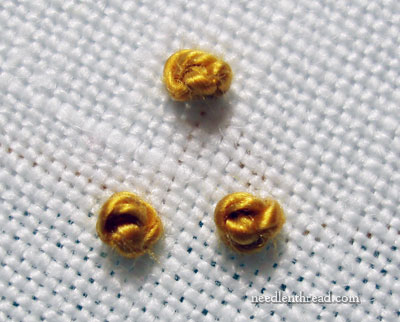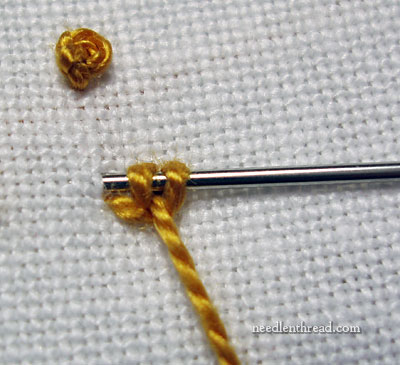I have a theory about embroidered knots. It’s not a profound theory. It’s actually a very simple theory, and it goes like this:
Seen one, seen ‘em all.
Whether you’re stitching the French knot or the colonial knot, in the final result, there’s no great difference between the two.

Which is which? Can you pick out the French knot(s) above or the colonial knot(s) above? And keep in mind, this photo is showing the knots to you at very close range. If you were seeing these in a finished piece of embroidery, would you be able to tell the difference? Probably not. (Ah – the problem with writing about knots is that every time I say “not,” you’re going to think I’m punning… when I’m… uh… not.)
Since there is no great difference in the end results between the French knot and the colonial knot, you can use them interchangeably.
Even though on the outside, the two knots pretty much look the same, the French knot and the colonial knot are created differently.

Here, you can see the twist of the thread on the needle as a French knot enters the fabric. You can see that the thread is simply twisted twice around the needle.

Here, you can see the twist of the thread on the needle as a colonial knot enters the fabric. The “figure 8″ twist used to create the colonial knot cause the thread to form more of a “hitch” than a “twist” on the needle.
In structure, then, the knots are slightly different, because they are made in a different way. To see the difference in action, feel free to take a look at my French knot video and my colonial knot video here on Needle ‘n Thread. (I just updated the colonial knot video with a new, HD version.)
What does all this mean for the embroiderer? Simply this:
Since you can use the knots interchangeably, you may find that one is easier for you to make than the other. Many stitchers who have difficulty with the French knot, for example, have no problem constructing the colonial knot, so they opt for it whenever a French knot is called for. And the opposite is true: if a colonial knot is called for in a design and you aren’t familiar with the colonial knot, you can opt for the French knot. In the end, no one will take you to task for substituting one for the other. And few people can see the difference.

But maybe you can! Which is which?
So which do you prefer, the French knot or the colonial knot? Do you use them interchangeably? Have you ever noticed a difference between them? Do you find one easier to make than the other? What’s your take on these knotty things? I’d love to hear your views – have your say below!
